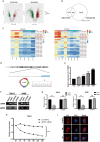Circular RNA circSDHC serves as a sponge for miR-127-3p to promote the proliferation and metastasis of renal cell carcinoma via the CDKN3/E2F1 axis
- PMID: 33468140
- PMCID: PMC7816303
- DOI: 10.1186/s12943-021-01314-w
Circular RNA circSDHC serves as a sponge for miR-127-3p to promote the proliferation and metastasis of renal cell carcinoma via the CDKN3/E2F1 axis
Abstract
Background: There is increasing evidence that circular RNAs (circRNAs) have significant regulatory roles in cancer development and progression; however, the expression patterns and biological functions of circRNAs in renal cell carcinoma (RCC) remain largely elusive.
Method: Bioinformatics methods were applied to screen for circRNAs differentially expressed in RCC. Analysis of online circRNAs microarray datasets and our own patient cohort indicated that circSDHC (hsa_circ_0015004) had a potential oncogenic role in RCC. Subsequently, circSDHC expression was measured in RCC tissues and cell lines by qPCR assay, and the prognostic value of circSDHC evaluated. Further, a series of functional in vitro and in vivo experiments were conducted to assess the effects of circSDHC on RCC proliferation and metastasis. RNA pull-down assay, luciferase reporter and fluorescent in situ hybridization assays were used to confirm the interactions between circSDHC, miR-127-3p and its target genes.
Results: Clinically, high circSDHC expression was correlated with advanced TNM stage and poor survival in patients with RCC. Further, circSDHC promoted tumor cell proliferation and invasion, both in vivo and in vitro. Analysis of the mechanism underlying the effects of circSDHC in RCC demonstrated that it binds competitively to miR-127-3p and prevents its suppression of a downstream gene, CDKN3, and the E2F1 pathway, thereby leading to RCC malignant progression. Furthermore, knockdown of circSDHC caused decreased CDKN3 expression and E2F1 pathway inhibition, which could be rescued by treatment with an miR-127-3p inhibitor.
Conclusion: Our data indicates, for the first time, an essential role for the circSDHC/miR-127-3p/CDKN3/E2F1 axis in RCC progression. Thus, circSDHC has potential to be a new therapeutic target in patients with RCC.
Keywords: E2F1 pathway; Renal cell carcinoma; circSDHC; miR-127-3p.
Conflict of interest statement
The authors declare that they have no competing interests.
Figures






Similar articles
-
Circular RNA circSDHC (hsa_circ_0015004) regulates tumor growth and angiogenesis via regulating centrosomal protein 55 expression in renal cell carcinoma.Histol Histopathol. 2022 Oct;37(10):971-983. doi: 10.14670/HH-18-467. Epub 2022 May 4. Histol Histopathol. 2022. PMID: 35506422
-
Circular RNA hsa_circ_0054537 sponges miR-130a-3p to promote the progression of renal cell carcinoma through regulating cMet pathway.Gene. 2020 Sep 5;754:144811. doi: 10.1016/j.gene.2020.144811. Epub 2020 May 25. Gene. 2020. PMID: 32464246
-
Circular RNA EGLN3 silencing represses renal cell carcinoma progression through the miR-1224-3p/HMGXB3 axis.Acta Histochem. 2021 Sep;123(6):151752. doi: 10.1016/j.acthis.2021.151752. Epub 2021 Jul 15. Acta Histochem. 2021. PMID: 34274607
-
Circular RNAs in EMT-driven metastasis regulation: modulation of cancer cell plasticity, tumorigenesis and therapy resistance.Cell Mol Life Sci. 2024 May 11;81(1):214. doi: 10.1007/s00018-024-05236-w. Cell Mol Life Sci. 2024. PMID: 38733529 Free PMC article. Review.
-
Role of the circular RNAs/microRNA/messenger RNA axis in renal cell carcinoma: From gene regulation to metabolism and immunity.iScience. 2025 Mar 11;28(4):112183. doi: 10.1016/j.isci.2025.112183. eCollection 2025 Apr 18. iScience. 2025. PMID: 40212586 Free PMC article. Review.
Cited by
-
The function and mechanisms of action of circular RNAs in Urologic Cancer.Mol Cancer. 2023 Mar 25;22(1):61. doi: 10.1186/s12943-023-01766-2. Mol Cancer. 2023. PMID: 36966306 Free PMC article. Review.
-
Systematic Review With Meta-Analysis: Diagnostic, Prognostic and Clinicopathological Significance of CircRNA Expression in Renal Cancer.Front Oncol. 2022 Jan 28;11:773236. doi: 10.3389/fonc.2021.773236. eCollection 2021. Front Oncol. 2022. PMID: 35155185 Free PMC article.
-
Hsa_circ_0001666 suppresses the progression of colorectal cancer through the miR-576-5p/PCDH10 axis.Clin Transl Med. 2021 Nov;11(11):e565. doi: 10.1002/ctm2.565. Clin Transl Med. 2021. PMID: 34841662 Free PMC article.
-
Analysis of Age-Related Circular RNA Expression Profiles in Mesenchymal Stem Cells of Rat Bone Marrow.Front Genet. 2021 Jun 28;12:600632. doi: 10.3389/fgene.2021.600632. eCollection 2021. Front Genet. 2021. PMID: 34262589 Free PMC article.
-
Circ_0007386 Promotes the Progression of Hepatocellular Carcinoma Through the miR-507/ CCNT2 Axis.J Hepatocell Carcinoma. 2024 Jun 13;11:1095-1112. doi: 10.2147/JHC.S459633. eCollection 2024. J Hepatocell Carcinoma. 2024. PMID: 38887684 Free PMC article.
References
Publication types
MeSH terms
Substances
LinkOut - more resources
Full Text Sources
Other Literature Sources
Medical

